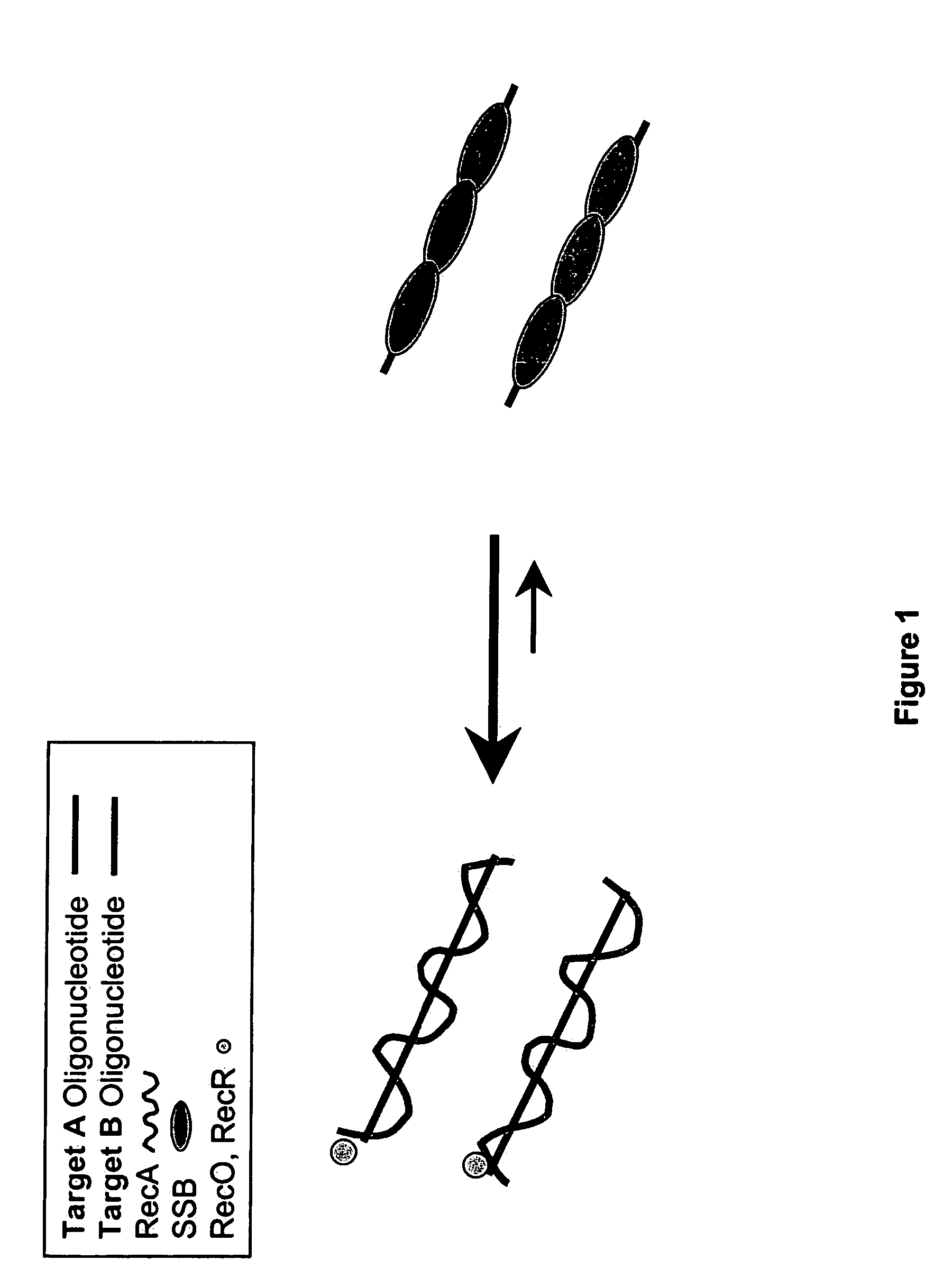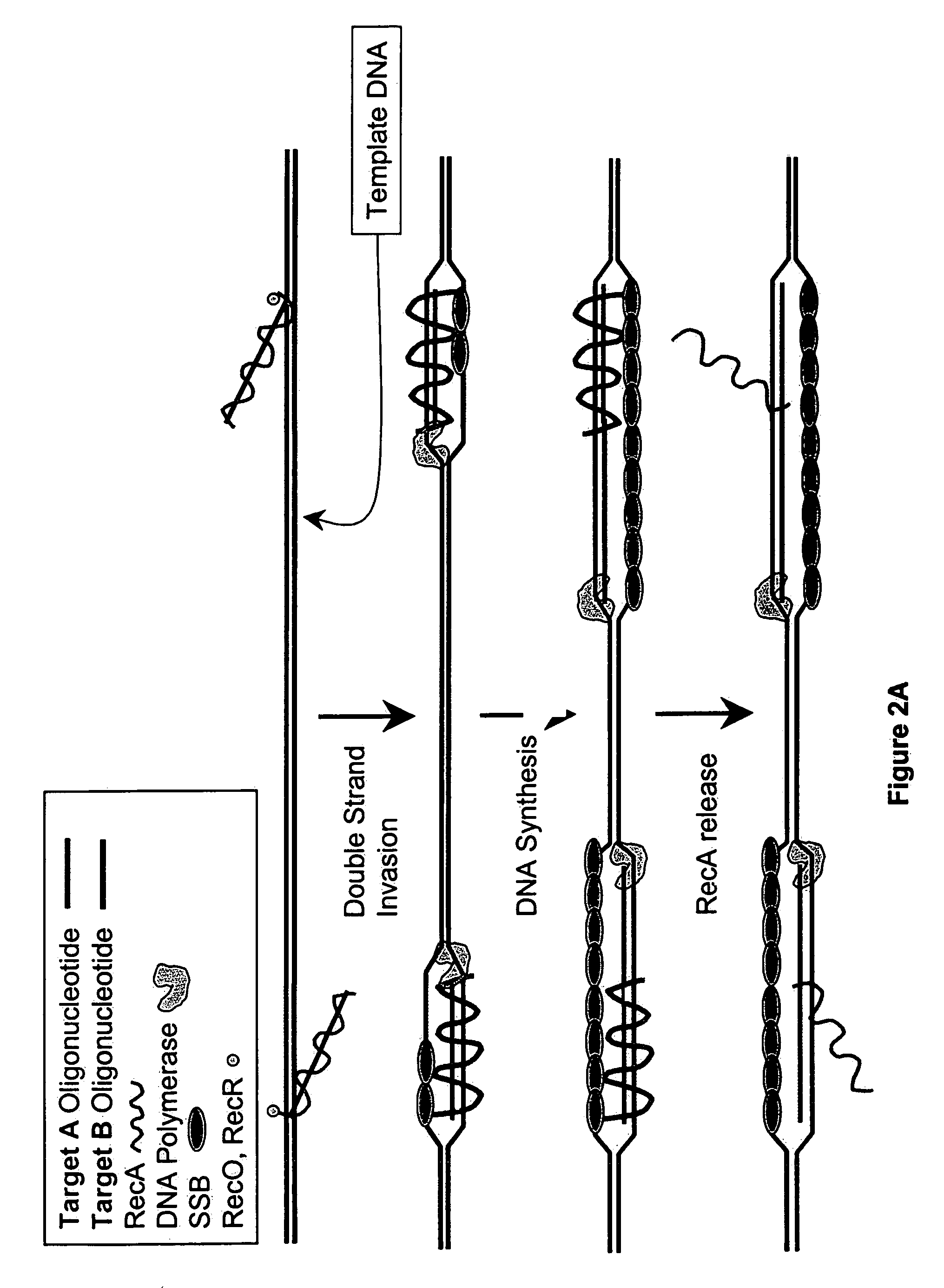Recombinase polymerase amplification
a technology of recombinase polymerase and amplification reaction, which is applied in the field of recombinase polymerase amplification, can solve the problems of inability to automate the approach of adding fresh polymerase, limited in a number of ways, and rely on multiples, so as to achieve optimal signal-to-noise properties, improve the cooperativity and/or strand assimilation, and improve the effect of amplification reaction
- Summary
- Abstract
- Description
- Claims
- Application Information
AI Technical Summary
Benefits of technology
Problems solved by technology
Method used
Image
Examples
example 1
An example of a Leading Strand Recombinase-Polymerase Amplification (lsRPA)
[0372]DNA sequences can be amplified using leading strand synthesis according to the Recombinase-Polymerase amplification (RPA) method depicted in FIG. 1. FIG. 1 shows RecA / primer loading. Prior to the addition of template DNA and / or Polymerase, RecA and SSB will compete for binding to single-stranded oligonucleotide primers. In the presence of a RecR and RecO, RecA is selectively stabilized onto the single-stranded primers forming RecA nucleoprotein filaments in a complex with RecO and RecR. This complex is competent to invade double-stranded DNA to form a D-loop at sites homologous to the oligonucleotide primers. Alternatively, RecA, RecO and RecR can be pre-loaded onto oligonucleotide primers prior to the introduction of SSB to the reaction mixture.
[0373]The following details the likely composition of an RPA reaction assembled with E. coli recA and E. coli recO and recR stabilizing agents:
[0374]
ComponentCo...
example 2
Nested RPA
[0379]The RPA reaction is performed as described in Example 1. A fraction of one tenth ( 1 / 10) and one hundredth ( 1 / 100) of the reaction is removed and used in place of the DNA template in a second round of RPA. LsRPA, leading / lagging RPA, and combinations thereof may be used for nested RPA.
example 3
Simultaneous Leading and Lagging Strand Recombinase-Polymerase Amplification
[0380]DNA sequences can be amplified using simultaneous leading and lagging strand synthesis according to the Recombinase-Polymerase amplification (RPA) method depicted in FIG. 2. This figure specifically illustrates lsRPA. FIG. 2A shows that RecA / primer nucleoprotein filaments invade double stranded template DNA preferentially associating with homologous target sites. As D-loops are formed and synthesis proceeds, displaced single stranded DNA becomes coated with SSB (FIG. 2A). RecA release from double-stranded DNA can occur via ATP hydrolysis in a 5′-3′ direction or as a result of helicase / resolvase or polymerase activity (FIG. 2A). As synthesis continues (FIG. 2B), polymerases encounter SSB bound, displaced single-stranded template. Double-stranded target sites are re-invaded by RecA / primer nucleoprotein filaments. Subsequent rounds of lsRPA proceed from re-invaded sites (FIG. 2B).
[0381]The following detai...
PUM
| Property | Measurement | Unit |
|---|---|---|
| reaction volume | aaaaa | aaaaa |
| reaction volume | aaaaa | aaaaa |
| reaction volume | aaaaa | aaaaa |
Abstract
Description
Claims
Application Information
 Login to View More
Login to View More - R&D
- Intellectual Property
- Life Sciences
- Materials
- Tech Scout
- Unparalleled Data Quality
- Higher Quality Content
- 60% Fewer Hallucinations
Browse by: Latest US Patents, China's latest patents, Technical Efficacy Thesaurus, Application Domain, Technology Topic, Popular Technical Reports.
© 2025 PatSnap. All rights reserved.Legal|Privacy policy|Modern Slavery Act Transparency Statement|Sitemap|About US| Contact US: help@patsnap.com



